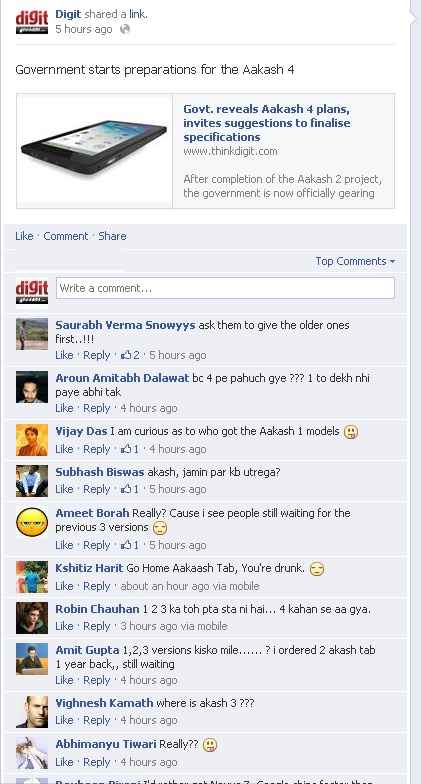Aakash 4: Will it be more than just pie in the sky?

So far, the Aakash hasn't delivered the results that everyone had expected from it two years ago. But it still remains an important mission! And now the government is working on the fourth version of the slate. Could the Aakash 4 change the trend?
We kicked off the day with the news of the government confirming plans for the fourth-generation of the Aakash tablet and seeking suggestions to finalise the technical specifications. Had it been 2011, this news would have set the Indian and global media abuzz with discussions on how India is set to become a dominant player in the field of Information Technology. There would also have been talks of an ultra-low-cost tablet would bridge the digital divide in the country. But in 2013, that high level of enthusiasm has evidently faded away. News that the government is readying another Aakash gets a lukewarm response from enthusiasts with most of them having a sceptical outlook on it.
That said, the passive response is very well expected, considering the government’s failure to ensure proper and timely implementation of the previous Aakash project. The Aakash 1 was phased out even before its launch (due to poor specifications), while the Aakash 2 took approximately two years to see the light of day. Forget about bridging the digital divide, the Aakash 2 tablets are yet to reach to the hands of students, teachers or whosoever it was meant for.
Yes, the Aakash did create a market for budget tablets. Companies such as Micromax, DataWind (UbiSlate tablets) and Karbonn are already milking the segment while the government is yet to make any progress in that direction.
While there’s still no clarity where the Aakash 2 project is heading, the government has started work on the Aakash 4! But, do we really need an Aakash 4 at this juncture? Shouldn’t the government focus on delivering the Aakash 2 units procured from DataWind to the students? And most importantly, where’s the Aakash 3?
The proposed specifications of the Aakash 4 makes it look like a decent tablet. Let’s have look at them: 7-inch LCD display with at least an 800×480 pixel resolution with 16-bit or higher colour depth, Android 4.2.1 (Jelly Bean), and Dual bootable (through external SD Card) GNU/Linux distribution (Latest Ubuntu), support for 3G/4G network and Wi-Fi.
The government seems to be more serious about the performance this time, as it wants 1GB of DDR3 SDRAM memory and meeting the minimum scores across various other benchmark tests like Antutu, AndEBench, PassMark Performance, RealPi, and CFBench. Check out the proposed Aakash 4 specifications in detail here (pdf).
Despite a decent set of specifications (albeit proposed), the future of the Aakash 4 a lot depends on the proper execution of the project. It’s notable the Aakash 2 or even the Aakash 1 had decent set of specs in their time, but by the time they could see the launch, the specs were outdated. We fear, same does not happen with the Aakash 4.
Fans responding to Aakash 4 news
The government has so far made big promises with hypes of “world’s cheapest tablet” and “India to become leader in Information and Technology”. We suggest the government to focus on delivering rather than hyping things around this time. There should be clearer guidelines and policies over manufacturing and quality, which would encourage the vendors to assist the government. Focus should be on quality rather quantity.
That said, the Aakash is still a powerful mission that envisages providing students from remote and far-flung areas access to modern technology and education. The government must do away with red-tape and set a deadline to actually see the project being implemented in letter and spirit.
Has the Indian government rushed ahead to the Aakash 4? Are you still excited over the Aakash project? Let me know your views on Twitter @1987kulbhushan or in the comments section below:


